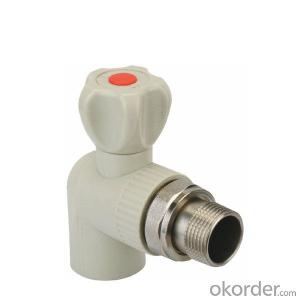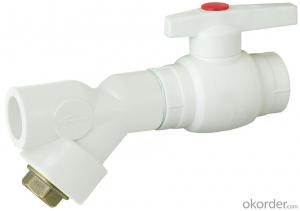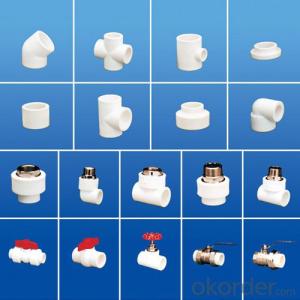Plastic Pipe Crimp Fittings PP-R Angle Radiator Brass Ball Valve with SPT Brand
- Loading Port:
- Ningbo
- Payment Terms:
- TT OR LC
- Min Order Qty:
- 1000 pc
- Supply Capability:
- 100000 pc/month
OKorder Service Pledge
OKorder Financial Service
You Might Also Like
Specification
Picture:


Product Applications:
Distribution for cool and hot water
Duct for drinkable water system
Pipes for kinds of high-temperature and low-temperature heating system
Pipes for heating and coolling settings in solar energy system
Connecting pipe for air conditioners
Product Advantages:
1) Healthy, bacteriological neutral, conforming to drinking water standards
2) Resistant to high temperatures, good impact strength
3) Convenient and reliable installation, low construction expenses
4) Excellent heat-insulation property from minimum thermal conductivity
5) Lightweight, convenient to transport and handle, good for labor-saving.
6) Smooth inner walls reduce pressure loss and increase flow speed
7) Sound insulation (reduced by 40% compared to galvanized steel pipes)
8) Light colors and excellent design ensure suitability for both exposed and hidden installation
9) Recyclable, environment-friendly, accords with GBM standards
FAQ:
Q1:How Can I Get A Sample?
A1:You can get samples by communicate with our export sales.
Q2:How Long Is Delivery?
A2:Delivery time will be30-45days according to order quantity.
Q3:What Is The MOQ?
A3:MOQ depends on different items.
Q4:What Is Our Normal Payments Terms?
A4:Our normal payment terms now is: T/T, L/C or western union,paypal
- Q: Are plastic pipe fittings resistant to UV degradation in indoor installations?
- Yes, plastic pipe fittings are typically resistant to UV degradation in indoor installations.
- Q: Can plastic pipe fittings be used for cooling water in power plants?
- Yes, plastic pipe fittings can be used for cooling water in power plants. Plastic pipe fittings are commonly used in cooling water systems due to their corrosion resistance, lightweight nature, and cost-effectiveness. They are capable of withstanding the temperature and pressure requirements of power plant cooling water systems while providing efficient and reliable performance.
- Q: Can plastic pipe fittings be used for chemical transportation?
- Plastic pipe fittings can be used for chemical transportation, but it depends on the type of chemical being transported. Certain plastic materials, such as PVC or CPVC, are resistant to a wide range of chemicals and can be suitable for transporting many types of chemicals. However, for more aggressive or corrosive chemicals, it is important to select the appropriate plastic material that is specifically designed to handle those substances. Additionally, it is crucial to consider factors like temperature, pressure, and compatibility with the specific chemical to ensure safe and effective transportation.
- Q: Are plastic pipe fittings compatible with solvent welding?
- Yes, plastic pipe fittings are compatible with solvent welding. Solvent welding is a common and effective method used to join plastic pipes and fittings together. It involves using a solvent cement that chemically bonds the plastic surfaces, creating a strong and leak-proof connection.
- Q: How do plastic pipe fittings handle soil movement and settlement?
- Plastic pipe fittings are designed to handle soil movement and settlement quite effectively. The flexibility of plastic materials allows them to withstand ground shifting, settling, and other movements without breaking or cracking. Additionally, plastic pipe fittings are typically joined with secure and flexible connections, such as solvent welding or compression fittings, which further enhance their ability to adapt to soil movement. This makes plastic pipe fittings a reliable choice for plumbing and drainage systems in areas prone to soil instability.
- Q: Are plastic pipe fittings compatible with electrofusion welding?
- Yes, plastic pipe fittings are compatible with electrofusion welding. Electrofusion welding is a commonly used method for joining plastic pipes and fittings together, providing a strong and reliable connection.
- Q: Can plastic pipe fittings be used for natural gas systems?
- No, plastic pipe fittings should not be used for natural gas systems. Natural gas is highly flammable and can pose a safety risk if not properly handled. It is recommended to use approved materials such as metal pipe fittings that are specifically designed and rated for natural gas applications.
- Q: How can the PPR pipe be connected with the metal tube?
- This is a water storage type electric water heater installation and use of PP-R material, and is connected with the water heater outlet and below the triangle valve components is a special joint installed in the water heater, the components are used to transition metal tube connected with the plastic pipe, the connecting way is to facilitate future maintenance.
- Q: Can plastic pipe fittings be used in irrigation drip systems?
- Yes, plastic pipe fittings can be used in irrigation drip systems. Plastic fittings are commonly used in drip irrigation systems due to their durability, affordability, and ease of installation. They are resistant to corrosion, provide a tight seal, and can withstand the pressure and flow rates required for efficient irrigation.
- Q: Are plastic pipe fittings easy to install?
- Yes, plastic pipe fittings are generally easy to install. They are lightweight, require minimal tools, and can be easily connected or disconnected using simple techniques such as solvent welding, compression fittings, or push-fit connections. Additionally, plastic pipe fittings are often designed with user-friendly features, making the installation process more convenient and straightforward for users.
Send your message to us
Plastic Pipe Crimp Fittings PP-R Angle Radiator Brass Ball Valve with SPT Brand
- Loading Port:
- Ningbo
- Payment Terms:
- TT OR LC
- Min Order Qty:
- 1000 pc
- Supply Capability:
- 100000 pc/month
OKorder Service Pledge
OKorder Financial Service
Similar products
Hot products
Hot Searches


























